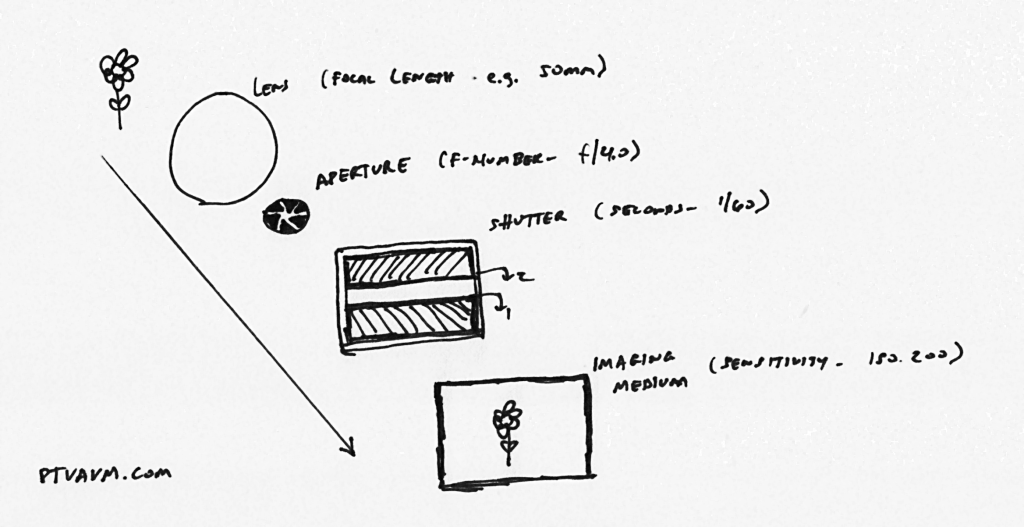A brief hand hand-sketched overview on how cameras work:
This post is my attempt to explain how the most fundamental parts play together inside a lens/camera and how they contribute to the resultant photo. Certainly use this as a starting point to go out and research using more comprehensive sources.
In the example below of taking a photo of a flower, the light travel through a lens, an aperture and a shutter to get to an imaging medium.
- Lens: the optical component that gets the subject (e.g. the flower) in focus to the camera. Uhm..there’s a lot of physics involved in explaining how lens works but for now we’ll use that to get going. Lens are described in “focal length”. Practically, the focal length is proportional to the angle of view.
- a shorter focal length (such as 20mm, or “wide angle” lens) gives a wide view to enable you to capture more within shot. Think landscapes, or taking pictures of people where you can’t back up far away. Sample: Canon EF 20mm f/2.8
- a longer focal length (“Telephoto Lens”) gives you a narrow view, to zoom in objects far away to fill in the frame. An extreme far reaching sample:
Canon EF 800mm f/5.6L IS USM Super Telephoto Lens
- a shorter focal length (such as 20mm, or “wide angle” lens) gives a wide view to enable you to capture more within shot. Think landscapes, or taking pictures of people where you can’t back up far away. Sample: Canon EF 20mm f/2.8
- Aperture: The diaphragm (or iris) that widens or narrows to control how much light passes through to reach the imaging medium. Aperture is denoted in “F-numbers” (f/N, where N is the f-number). An f-number is basically a ratio of the lens’ focal length to the diameter of the aperture. While I’ve drawn the aperture above as a set of mechanical closing blades/leaves, there are various designs of apertures.
- A wider aperture (lower f-number, such as f/2.0) allows for more light to pass though over a given time, while giving you a shallow depth-of-field.
- A narrow aperture (higher f-number, such as f/16), allows less light to pass through over a given time, while providing a deeper depth-of-field.
- Shutter: the plane that opens, and then immediately closes to allow light to pass through to expose the imaging medium. Typically this is accomplished with a first
“curtain”opening the frame, while second “curtain” chases the first “curtain” to evenly expose the imaging medium via a sliding window. While I’ve drawn a shutter above to represent a vertical-travel focal plane shutter, there are various designs of shutters. In operation, a camera shutter is parametrized as time in seconds, or fractions of seconds. (e.g. 2 seconds, 1/4th second, 1/60th second)- A slower shutter speed exposes the imaging medium over a longer time.
- A faster shutter speed exposes the imaging medium over less time.
- Imaging Medium: this is the component onto which the light from outside the lens and passes through the internal lens/camera components is exposed. Back in my day, this was film that we loaded in the back of a camera. Nowadays it typically refers to an image sensor. The imaging medium is characterized/set by its sensitivity, referred to as ISO.
Hopefully this provides a better understanding of that’s going on when you operate a camera. Look for future posts to build upon this article.
Its honestly silly to actually promote products on a “primer” page, so the external product links are really more for showing examples. I wouldn’t expect anyone to immediately rush out and get a wide angle lens, and especially not a monster $13k+ telephoto lens.
I definitely DO NOT OWN a 800mm telephoto lens at time of this writing, and therefore express no opinion of it. However, I do own and heavily use a Canon EF 20mm f/2.8
.
[*] Product links included on this page lead to external merchant site(s) in which this site participates in a link referral program. More information may be found on our “Support Us!” page.

